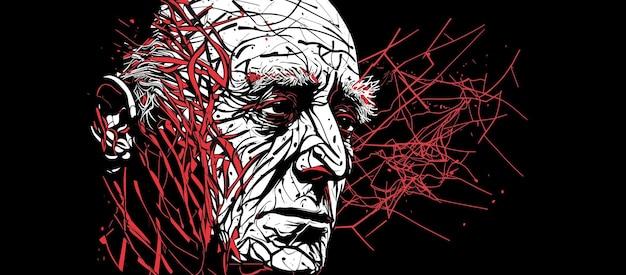Welcome to my blog post, where we delve into the fascinating literary elements used in Edgar Allan Poe’s chilling tale, “The Tell-Tale Heart.” Published in 1843, this iconic short story continues to captivate readers with its dark and suspenseful narrative.
In this post, we will explore the various literary devices employed by Poe, including symbolism, personification, and plot elements that contribute to the overall theme. So have no fear, dear reader, as we uncover the answers to questions such as the duration of the narrator’s stalking, the plot structure, and how specific elements accentuate the story’s profound effect.
Let’s embark on a journey through the mind of a tormented narrator, as we dissect the literary brilliance of “The Tell-Tale Heart” and unearth its timeless allure.

Literary Elements in “The Tell-Tale Heart”
Edgar Allan Poe’s Masterpiece
“The Tell-Tale Heart” by Edgar Allan Poe is a gothic masterpiece that showcases the author’s exemplary use of literary elements to create a chilling and suspenseful atmosphere. Let’s dive into the story’s key literary elements and unravel the web of intrigue Poe has spun.
The Art of Foreshadowing
Poe expertly employs foreshadowing throughout the narrative, setting the stage for the haunting events to come. From the very beginning, the protagonist’s insistence on their sanity raises a niggling doubt, hinting at a deeper, darker truth. As the story unfolds, subtle hints about the gruesome outcome of the tale are sprinkled like breadcrumbs, leading us down a path of mounting unease.
The Power of Symbolism
Symbolism seeps through the pages of “The Tell-Tale Heart” like a phantom presence. The most prominent symbol is undoubtedly the old man’s vulture-like eye, which represents the protagonist’s obsession and guilt. This grotesque eye acts as a voyeuristic window into the soul of the narrator, intensifying the sense of paranoia and guilt that drives the story forward.
The Heart’s Beating Rhythm
The constant beating of the heart serves as a morbid leitmotif that underlines the narrator’s descent into madness. This auditory hallucination becomes a relentless reminder of the protagonist’s guilt, growing louder and more torturous as the story progresses. Poe’s use of this haunting element hooks the reader’s attention while mirroring the narrator’s growing sense of dread.
The Art of Unreliable Narration
Poe employs the technique of an unreliable narrator to great effect in “The Tell-Tale Heart.” The protagonist’s gradual reveal of their disturbed state of mind creates a captivating sense of ambiguity. As readers, we question the reliability of every word, generating a sense of unease and drawing us deeper into the story’s dark and twisted depths.
The Sublime Power of Language
Poe’s mastery of language is on full display in “The Tell-Tale Heart.” His carefully chosen words craft vivid imagery that lingers in the mind long after the story has been read. The use of rich descriptive passages, coupled with a relentless pace, heightens the story’s suspense and ensures the reader is constantly on the edge of their seat.
The Dark Side of Human Psychology
Above all, “The Tell-Tale Heart” delves into the darkest recesses of the human psyche. Through the portrayal of the narrator’s irrational thoughts and erratic behavior, Poe explores themes of guilt, obsession, and the blurred boundaries between sanity and madness. This psychological exploration serves as a chilling reminder of the fragile nature of the human mind.
In conclusion, Edgar Allan Poe’s “The Tell-Tale Heart” is a literary marvel that showcases the author’s mastery of various literary elements. From the art of foreshadowing to symbolism and the power of language, Poe’s skillful use of these techniques creates a gripping and unforgettable reading experience. As we immerse ourselves in the dark and twisted world of this classic tale, we are reminded of the impact that well-crafted literary elements can have on a story.

FAQ: Literary Elements in “The Tell-Tale Heart”
In the classic short story “The Tell-Tale Heart” by Edgar Allan Poe, there are several literary elements that contribute to its gripping and chilling narrative. From the use of suspense to the exploration of the theme, this FAQ-style guide will provide answers to your burning questions about the literary elements found in this macabre tale.
Q: How many nights did the narrator stalk the old man
The narrator in “The Tell-Tale Heart” stalks the old man for eight consecutive nights. This repeated intrusion into the old man’s chamber adds to the suspense and sets the stage for the unfolding madness that drives the story.
Q: What literary elements are utilized in “The Tell-Tale Heart”
Several literary elements are skillfully employed in “The Tell-Tale Heart” to heighten its impact on readers. Here are a few noteworthy ones:
Suspense
Poe masterfully builds suspense throughout the story by maintaining a sense of mystery and tension. Through the narrator’s meticulous planning and the creeping dread of discovery, the story’s suspense grips readers tightly from start to finish.
Symbolism
“The Tell-Tale Heart” employs symbolism to convey deeper meanings. For example, the beating of the old man’s heart symbolizes the guilt that haunts the narrator, representing his wavering sanity and the relentless pursuit of the truth.
Point of View
The story is narrated from a first-person point of view, allowing readers to experience the events through the eyes of the unreliable narrator. This technique adds a layer of intrigue and creates a closer connection between readers and the disturbing thoughts of the narrator.
Q: Which plot element aids readers in determining the story’s theme
The plot element that most helps readers determine the theme of “The Tell-Tale Heart” is the rising action and climax. As the story progresses, the narrator’s obsession and paranoia escalate, culminating in the shocking climax where his guilt is ultimately revealed. This intense buildup highlights the theme of the destructive power of guilt and the torment it inflicts on the human psyche.
Q: Can you provide an example of personification in “The Tell-Tale Heart”
Certainly! In “The Tell-Tale Heart,” there is an instance of personification when the narrator describes the old man’s eye as “evil.” By attributing the quality of evil to the eye, the author gives the inanimate object human-like characteristics, heightening the sense of unease and adding to the atmosphere of psychological horror.
Q: What is the plot of “The Tell-Tale Heart”
“The Tell-Tale Heart” follows a gripping plot that delves into the depths of the narrator’s disturbed mind. The story begins with the narrator’s obsession and eventual decision to murder the old man. As he stalks the old man, tension builds until he finally carries out his sinister plan. However, guilt consumes him, and he begins to hallucinate the sound of the old man’s heartbeat, leading to his complete mental unraveling, which ultimately culminates in his confession.
“The Tell-Tale Heart” expertly employs various literary elements to create a gripping and unforgettable reading experience. From the suspenseful narrative to the symbolic representations throughout the story, Edgar Allan Poe’s use of literary techniques leaves readers both enthralled and unnerved. By understanding and appreciating these elements, readers can fully immerse themselves in the dark and twisted world of this classic tale.
Remember, “The Tell-Tale Heart” serves as a testament to the enduring power of Poe’s storytelling and his ability to tap into the darkest recesses of the human psyche. Happy reading!
Disclaimer: This article is solely for informational purposes and does not constitute medical or legal advice.
